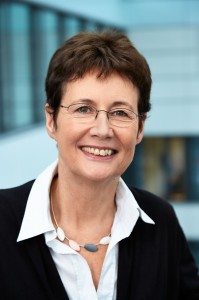
Analysis… Innovations for better health
Speaking to Portal, Dr Ursula Redeker, ad interim CEO, EIT Health, detailed the latest developments in setting up EIT Health KIC. With potential funding cuts on the horizon, she sets out how the KIC will meet its ambitious objectives.
EIT Health is one of the latest Knowledge and Innovation Communities (KIC) to be launched by the European Institute of Innovation and Technology (EIT). The KIC aims to address Europe’s health problems with innovative solutions, encouraging European citizens to pursue a healthy life whilst remaining active in their older years. EIT Health is a consortium of more than 50 core partners and 90 associate partners from leading businesses, research centres and universities from across 14 EU countries.
The KIC is seeking to achieve a number of ambitious goals by 2018: create 80 start-ups each year; have one million students taking part in its online educational programmes; and support 80 new products/services every 12 months. Furthermore, EIT Health aims to, within its first full year of operation, incubate approximately 80 new business ideas, rising to 140 in 2018. Overall we are communicating that by 2018 340 business ideas will be incubated.
In May, the KIC had the opportunity to showcase its priorities at INNOVEIT 2015, a major conference focusing on the work of the EIT, in the Hungarian capital Budapest. On the sidelines of the three-day conference, Portal caught up with Dr Ursula Redeker, EIT Health interim chief executive, who outlined the latest steps in setting up the KIC, meeting these bold objectives, and the impact of a potential funding reduction from the EIT.

Dr Ursula Redeker
What have been the major developments in setting up EIT Health over the last six months?
We have already achieved important milestones in bringing EIT Health to life as the largest health and business initiative in Europe. This includes ensuring that, upon the signing of the start-up grant agreement, the financial conditions for a successful implementation phase are in place, setting up all the
co-location centres, putting into practice governance processes, and initiating the process of creating a strong portfolio of projects in line with our business objectives.
We are now entering the exciting phase of building a KIC, assessing the project proposals we have received, and marrying together the partners involved in the various activities to develop a joint project. A business plan will be submitted to the EIT at the end of September. Many people attending INNOVEIT 2015 have been from the EU, the EIT and KIC communities, and we are greatly enjoying the interest in our work and the recognition we are receiving.
With a high number of partners involved, how are you ensuring all these voices are being heard?
The voices want to be heard in different ways, and one of the most important methods is to help our partner organisations in fully leveraging the capacities of the EIT Health network in driving their innovation projects. In May, we ran a brokerage event in Munich, Germany, to provide our partner organisations with the opportunity to establish relations with other EIT Health organisations that are complementary to their innovation projects. The strong capacities, whether in the form of multidisciplinary knowledge or infrastructure, that EIT Health offers to its partner organisations remain a key asset of the network.
Apart from the strong influence our partner organisations have through the governance boards, we devote a lot of attention towards supporting them in extending their options to fast-track their innovation projects.
How will you meet the ambitious targets of creating 80 start-ups by 2018 and having one million students participating in your online education programmes?
One million students is a big number, but if you look at the population of Europe, it’s only a fraction. We are strongly convinced that we have the right concepts at hand to expand our outreach to an extent that allows us to reach our goals in the field of higher education. Consequently, there is less of a concern on the student front.
Another key factor to meeting our goals will certainly be on not overemphasising early R&D, but rather to focus our investments on projects which fulfil key requirements – from both an innovation and a business standpoint.
Nevertheless, we have significant budget cuts ahead for the EIT. Whilst they have not yet been completely quantified, it’s likely that these cuts will be felt. We will therefore have to scale down those numbers – we cannot possibly have that impact when a budget is cut by half or even more. We will then have to see how we recompense if the originally planned funding returns in the coming years. Yet the fact remains: the announcement of the alteration of the financial foundations does not constitute the best indication of reliable framework conditions and will significantly burden our work and efforts.
To what extent will the KIC be looking for other sources of funding besides those provided by the EIT?
The KIC co-funding model foresees a share of 25% of the overall budget coming from the EIT, with 75% to be attracted from other sources, both public and private. The EIT funding approach is different and unique compared to other European funding models as it is purposely aimed at fostering collaboration between the three areas of the knowledge triangle, namely business, higher education and research. It is this particular approach that is also highly appealing to our partner organisations as it offers unique opportunities to enter into dialogue with partners with whom you usually do not have contact.
Furthermore, in the early years, it is possible to delay EIT funding and inject more in-kind contribution of our own funding for the KIC, and this is one of the strategies we are following.
How do you ensure that EU citizens benefit from the public funding that is poured into EIT Health?
We focus on excellence in innovation and creating impact within the short and medium term. Thus we focus on products, services and ideas which will be launched into the market in the next two to three years and thus are already close to market launch. In doing so, we will pursue a very customer and market-oriented approach.
It is important for us not only to deliver a product, but a product that is really appreciated and creates value in the hands of our customers from a medical, care or life perspective. Some deliverables will be a product you may purchase, but we will also promote new services and process innovations to further drive important future trends such as personalised healthcare.
What kind of relationship will EIT Health establish with other EU strategies?
The area of health is linked to a number of directorates-general because it has economic, education and research impacts. We are now drafting a business plan and the strategic roadmap for the next three years, where we will reach a decision concerning what areas we really want to focus on in a very targeted way. We will upon decide which EU programmes and strategies should best be joined together and would constitute a move supported by many directorates-general.
Dr Ursula Redeker
This article first appeared in the seventh edition of Horizon 2020 Projects: Portal, which is now available here.




